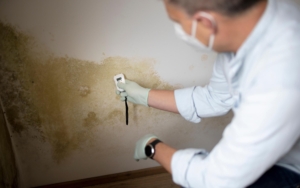Step 1: Emergency Response & Initial Containment
When you contact Prime Time Restoration, our emergency response team arrives within [TIME FRAME] to begin immediate containment procedures. We understand that mold contamination can spread rapidly, so quick action is essential to prevent further damage.
Immediate Actions Include:
- Assessment of immediate health and safety risks
- Establishment of containment barriers using plastic sheeting
- Installation of negative air pressure systems
- Shutdown of HVAC systems to prevent spore distribution
- Documentation of existing conditions
- Development of remediation action plan
Step 2: Advanced Mold Containment & Isolation
Proper containment is critical to prevent cross-contamination to unaffected areas of your property. Our technicians establish engineering controls using industry-leading techniques and equipment.
Containment Procedures:
- Physical barriers using 6-mil polyethylene sheeting
- Negative air pressure chambers with HEPA filtration
- Airlocks and decontamination chambers for worker entry/exit
- HVAC system isolation and protection
- Critical barrier installation for highly contaminated areas
- Continuous air monitoring throughout the process
Step 3: HEPA Air Filtration & Environmental Controls
We deploy hospital-grade HEPA air filtration systems that remove 99.97% of particles 0.3 microns and larger, including mold spores, from the air during remediation.
Air Filtration Equipment:
- Portable HEPA air scrubbers with variable speed controls
- Negative air machines for containment pressure maintenance
- Continuous air monitoring with particle counters
- Pre-filters to extend HEPA filter life
- Real-time air quality monitoring systems
Step 4: Safe Mold Removal & Material Disposal
Our certified technicians follow strict protocols for the safe removal of mold-contaminated materials. We use HEPA-filtered vacuuming, antimicrobial treatments, and proper disposal methods to eliminate contamination sources.
Removal Techniques:
- HEPA vacuum cleaning of all surfaces
- Wire brushing and sanding of porous materials
- Removal and disposal of heavily contaminated materials
- Chemical treatment of remaining surfaces
- HEPA vacuuming between each cleaning step
- EPA-registered disinfectant application
Step 5: Antimicrobial Treatment & Surface Sanitization
After physical mold removal, we apply EPA-registered antimicrobial solutions to all affected surfaces. These treatments eliminate remaining mold spores and help prevent future growth.
Treatment Applications:
- Broad-spectrum antimicrobial solutions
- Mold inhibitor application to cleaned surfaces
- Encapsulation of porous materials when appropriate
- Fogging treatment for hard-to-reach areas
- Multiple application cycles for heavily contaminated areas
Step 6: Structural Drying & Moisture Control
Since moisture is the root cause of mold growth, we implement comprehensive drying protocols to eliminate excess moisture and prevent future contamination.
Drying Equipment & Techniques:
- Industrial-grade dehumidifiers
- High-velocity air movers for enhanced evaporation
- Injectidry systems for wall cavity drying
- Moisture monitoring with digital meters
- Daily documentation of drying progress
- Psychrometric calculations for optimal drying conditions
Step 7: Post-Remediation Verification & Clearance Testing
We don’t consider the job complete until independent testing confirms that your property meets established safety standards for mold spore levels and indoor air quality.
Verification Process:
- Visual inspection of all remediated areas
- Independent third-party air quality testing
- Surface sampling verification
- Moisture level confirmation
- Photo documentation of completed work
- Clearance certification for occupancy




